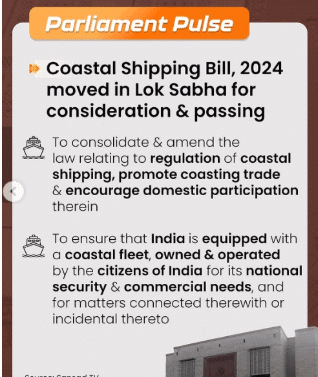PIB Summary- 4th April, 2025 | PIB (Press Information Bureau) Summary - UPSC PDF Download
Lok Sabha Passes the Coastal Shipping Bill, 2024
Context
The Lok Sabha passed the Coastal Shipping Bill, 2024, establishing a legal framework for coastal trade.
It aims to enhance maritime transport, reducing congestion on roads and railways.

Key Provisions of the Coastal Shipping Bill, 2024
Legal Framework for Coastal Shipping
- Creates a special law for coastal trade, replacing old rules from the Merchant Shipping Act, 1958.
- Aims to make coastal shipping more organized and efficient.
Licensing Rules for Foreign Ships
- Foreign ships can carry goods along India’s coast only with special permission from the Director General of Shipping.
- Ensures that Indian shipping companies get priority.
National Coastal and Inland Shipping Strategic Plan
- Requires a detailed plan for improving coastal and inland water transport.
- The plan will be updated every two years to match future needs.
National Database for Coastal Shipping
- Sets up a database to track coastal trade and help in better decision-making.
- Helps in planning and improving efficiency.
Simplified Rules for Indian Ships
- Indian ships no longer need a general trading license, reducing paperwork.
- Makes it easier for companies to operate in coastal trade.
Support for Indian Shipbuilding and Jobs
- Encourages building more ships in India under ‘Make in India.’
- Creates jobs in shipbuilding, ports, and vessel operations.
Cooperation Between Center and States
- Ensures states and union territories are involved in planning and decision-making.
Faster Port Services
- Provides quicker berthing for coastal ships and faster environmental clearances.
Linking with National Logistics Policy
- Aligns with India’s logistics vision to reduce transport costs and improve trade.
Unravelling the Mysteries of Pope’s Pit Viper Venom: A deadly snake of North East India
Context
A new study reveals the venom composition of Pope’s Pit Viper, a snake found in northern and northeastern India. This research aids venom toxicity understanding and antivenom development.
Pope’s Pit Viper – Key Information

- Native Habitat: Found particularly in dense forests of northern and northeastern India, Myanmar, Malaysia, and Thailand.
- IUCN Red List Status: Least Concern
- Physical Features: A striking green-colored pit viper with a slender body, triangular head, and heat-sensing pits near its eyes.
- Behavior: Arboreal (tree-dwelling) and nocturnal, active mostly at night.
- Diet: Feeds on small mammals, birds, amphibians, and reptiles.
- Venom Composition: Contains 106 proteins, including toxic enzymes like snake venom metalloproteinases (SVMPs), serine proteases (SVSPs), and phospholipases A2.
- Effects of Venom: Causes bleeding, tissue damage, blood clotting issues, muscle injury, and inflammation.
- Medical Significance: No species-specific antivenom is available, making bites difficult to treat.
- Conservation Status: Not well-documented, but habitat loss poses a threat.
Seaweed: A Nutritional Powerhouse From The Ocean
Context
- India’s vast coastline holds immense potential for seaweed farming, which offers economic, nutritional, and environmental benefits.
- Government initiatives like PMMSY are promoting large-scale seaweed cultivation to enhance livelihoods and sustainability.
Introduction
- India has a 7,500 km-long coastline, offering vast potential for economic growth.
- Seaweed farming is becoming an important livelihood option for coastal communities.
What is Seaweed?
- Seaweed is a marine plant that grows in oceans and does not need land or freshwater.
- It is used in food, cosmetics, fertilizers, and medicine.
- Seaweed is rich in vitamins, minerals, and amino acids, making it a nutritious food.
- It helps fight diseases like cancer, diabetes, and heart problems while boosting immunity.
Uses of Seaweed in Industries
- Alginate (US$ 213 million) – Used in food, cosmetics, and medical products.
- Agar (US$ 132 million) – Used in desserts, jams, and laboratory cultures.
- Carrageenan (US$ 240 million) – Used in dairy products, ice cream, and toothpaste.
Global Seaweed Market
- Seaweed has been consumed since ancient times, especially in Japan and China.
- The global seaweed industry is valued at US$ 5.6 billion.
- Emerging seaweed markets could grow by up to US$ 11.8 billion by 2030.
Seaweed Farming in India
- Out of 844 seaweed species in India, 60 are commercially valuable.
- The government supports seaweed farming through policies, funding, and research collaborations.
- Under the PMMSY scheme, ₹640 crore has been allocated for seaweed cultivation from 2020-2025.
- ₹194.09 crore is being used for major projects like a Seaweed Park in Tamil Nadu and a Seaweed Brood Bank in Daman and Diu.
- India aims to produce 1.12 million tonnes of seaweed in five years.
Benefits of Seaweed Farming
- Supports Agriculture – Seaweed is used as a biostimulant to improve soil health and crop yield.
- Promotes Organic Farming – Encouraged under government schemes like PKVY and MOVCDNER.
- Environmental Benefits – Absorbs CO₂, cleans ocean water, and provides shelter for marine life.
- Economic Opportunities – Farmers can earn up to ₹13,28,000 per hectare per year.
- High Demand Products – Biofuels, fertilizers, and other seaweed-based products help India earn foreign currency.
Recent Developments
- Women Empowerment in Seaweed Farming – Coastal women have started their own businesses, creating employment and financial stability.
- Tissue Culture Technology – Advanced methods have increased seaweed production and quality.
Conclusion
- Seaweed farming provides jobs and additional income for coastal communities.
- With continued investment, seaweed farming can boost India’s economy and promote sustainability.
















